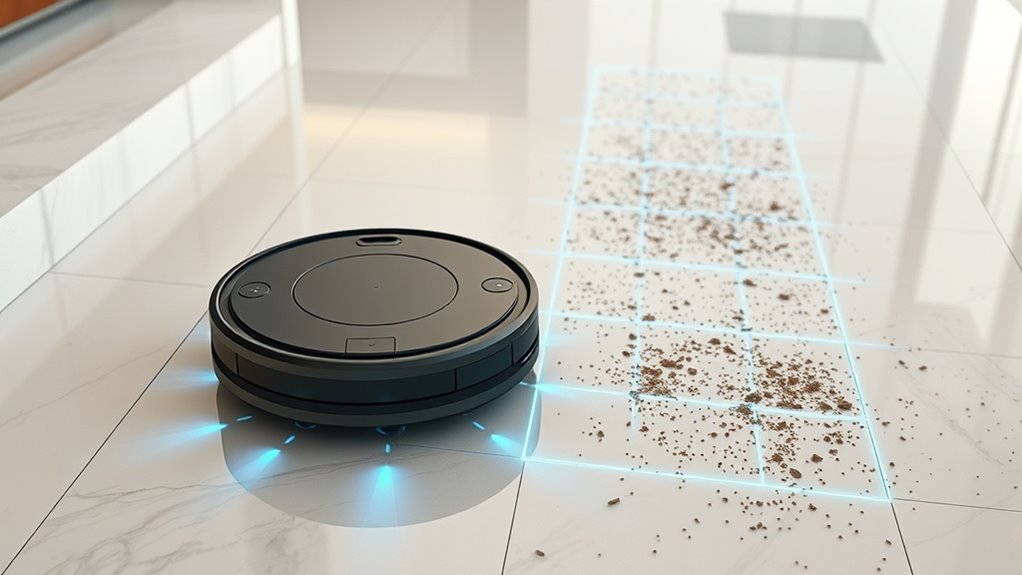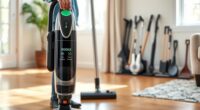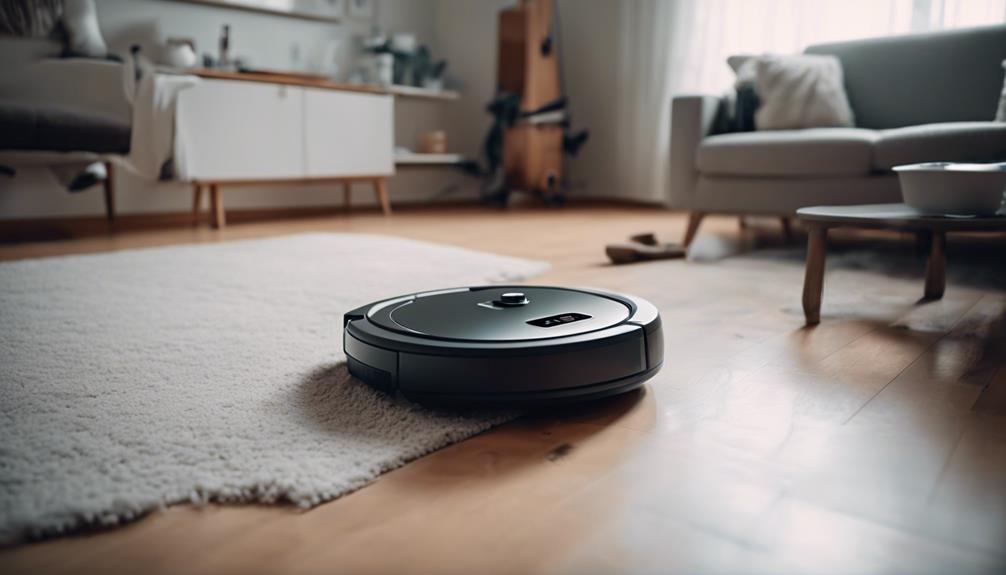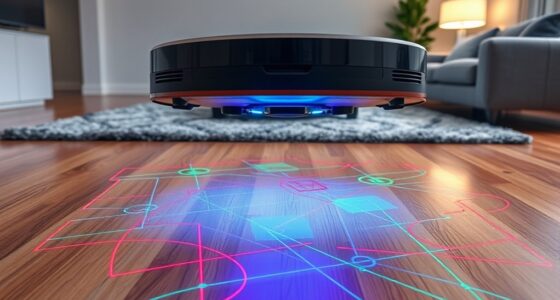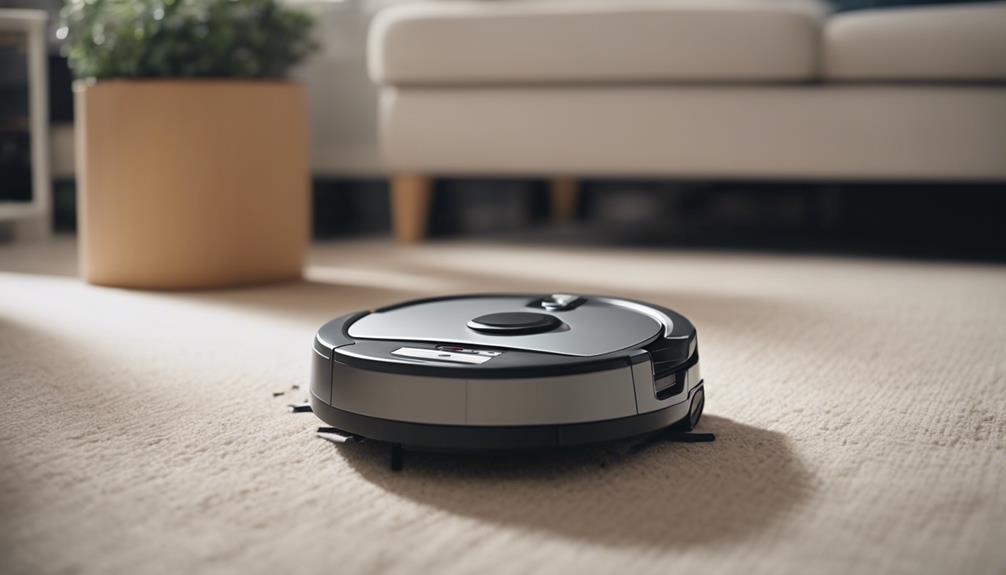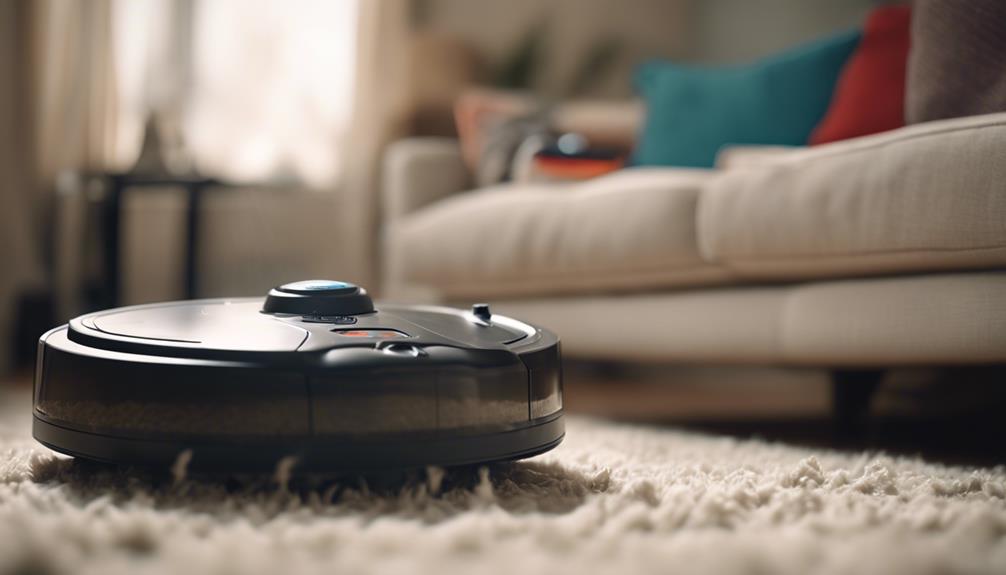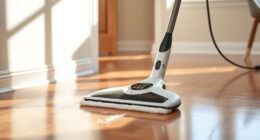Mapping vacuums use sensors to create detailed layouts of your space, allowing for systematic cleaning, better coverage, and route optimization. Random vacuums move unpredictably, often missing spots and draining batteries faster. While mapping models cost more upfront, they save time and energy in the long run. Understanding these differences helps you pick the right option for your home. Keep exploring to discover what suits your cleaning needs best.
Key Takeaways
- Mapping vacuums create precise room layouts, enabling thorough and efficient cleaning, unlike random vacuums that may miss spots or double back.
- Random vacuums are generally less expensive but may drain batteries faster and provide less consistent coverage.
- Mapping systems adapt to obstacles and layout changes in real-time, improving navigation and coverage over random models.
- For complex homes or large spaces, mapping vacuums offer better route optimization, reducing cleaning time and missed areas.
- Noise levels and home-specific needs (pets, allergies, quiet operation) influence the choice between mapping and random navigation vacuums.
How Mapping Technology Works in Floor Care Devices
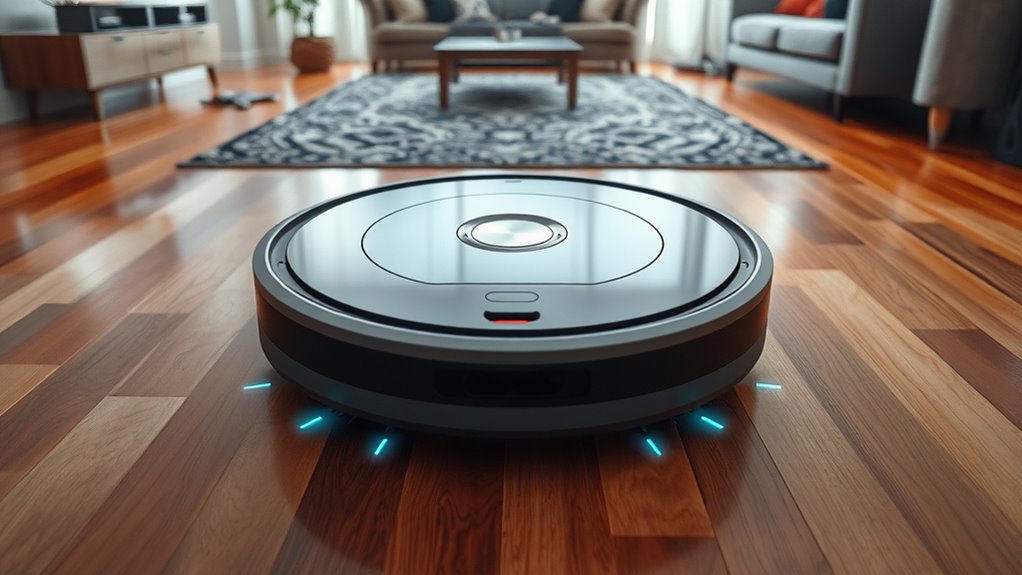
Mapping technology in floor care devices works by creating a detailed layout of your space as the robot navigates. This process relies heavily on sensor accuracy to detect walls, furniture, and obstacles, ensuring precise mapping. High sensor accuracy allows the device to differentiate between objects and recognize boundaries, reducing missed spots. As the robot moves through your home, it updates its map in real-time, adapting to new obstacles or changes in layout. Map updating is essential for maintaining an accurate representation of your environment, especially in dynamic spaces. The device continuously refines its map during cleaning, enabling efficient navigation and thorough coverage. By leveraging sensor accuracy and real-time map updating, these devices optimize cleaning paths and minimize redundant passes. Sensor precision plays a crucial role in the effectiveness of mapping technology, ensuring thorough coverage and minimizing missed areas during cleaning.
The Advantages of Mapping Over Random Navigation
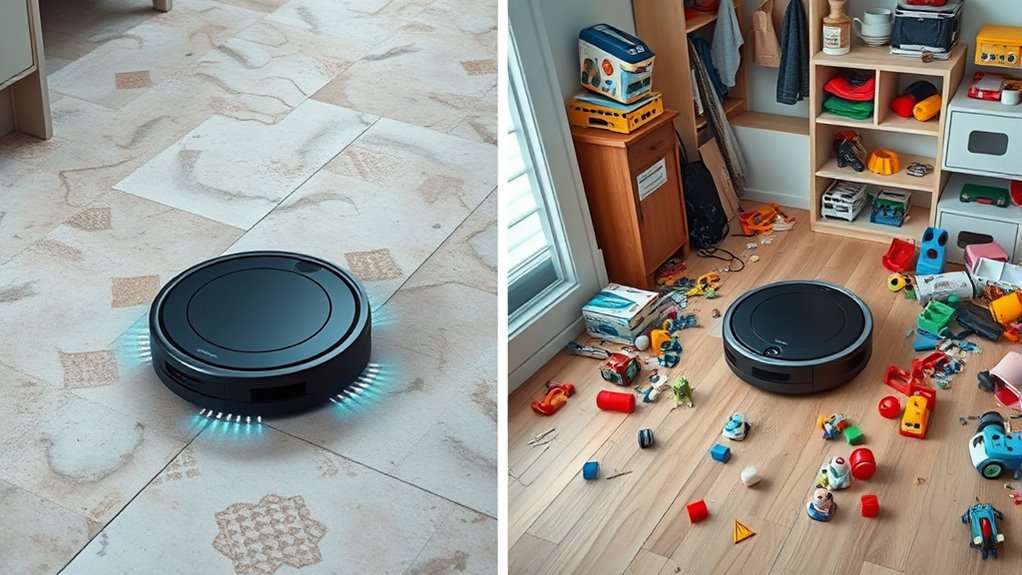
With mapping technology, you can cover specific areas more accurately, ensuring no spot is missed. This precision helps reduce the overall cleaning time, making the process more efficient. By choosing mapping over random navigation, you get faster, more reliable results. Additionally, smart features like app control and scheduling enhance the overall cleaning experience and convenience.
Precise Area Coverage
When it comes to covering an area efficiently, mapping offers a clear advantage over random navigation. With mapping, your vacuum can perform precise area segmentation, guaranteeing every part of your space gets cleaned thoroughly. This technology allows the device to create a detailed map of your home, guiding it to focus on specific zones and avoid missed spots. Obstacle detection plays a vital role here, enabling the vacuum to identify furniture, walls, and other obstacles in real time. Instead of aimlessly wandering, it plans an ideal route, maximizing coverage without redundancy. This targeted approach minimizes missed areas and guarantees a more consistent clean. Additionally, effective mapping enhances the vacuum’s ability to adapt to different floor types and layouts, ensuring optimal performance across your entire home. Ultimately, mapping delivers a smarter, more methodical cleaning process, giving you peace of mind that your entire space is covered accurately.
Reduced Cleaning Time
By planning an efficient route, mapping technology considerably reduces the time it takes to clean your home compared to random navigation. It intelligently detects dirtier areas using dirt detection sensors, allowing the vacuum to spend more time where it’s needed most. This targeted approach minimizes unnecessary passes, speeding up the cleaning process. Additionally, mapping systems optimize path routes, avoiding redundant coverage and reducing overall cleaning time. They also help control noise levels by limiting the vacuum’s operation in sensitive areas or at specific times. With a clear layout of your space, the vacuum can work more efficiently, completing tasks faster without sacrificing thoroughness. Enhanced color accuracy in the system’s sensors can further improve dirt detection precision. Overall, mapping technology ensures quicker, quieter, and more effective cleaning sessions.
Common Myths About Random Navigation Vacuums
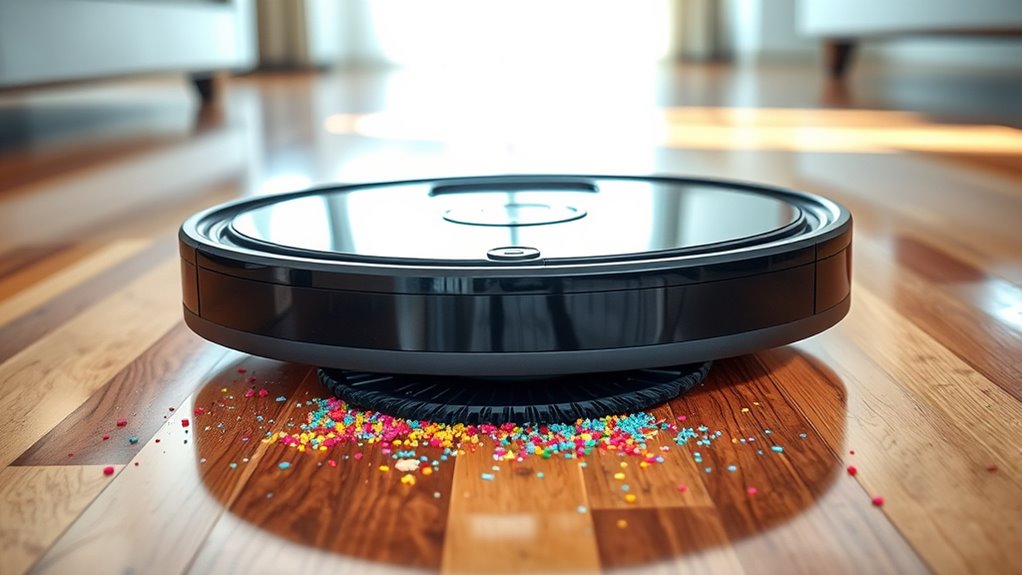
Many people assume that random navigation vacuums are inefficient or unreliable, but this isn’t always true. A common myth is that they quickly drain their battery lifespan, but many models are designed to optimize cleaning cycles and conserve power. Additionally, some think these vacuums are excessively noisy, making them disruptive. In reality, noise levels vary depending on the model, and many operate quietly enough for use while you’re home. While they may not map out your space, they can still clean effectively with proper scheduling. The myth that they’re inherently inferior ignores advancements in technology, which have improved both their efficiency and user experience. For example, Eye Patch Benefits show that targeted ingredients can enhance appearance even with temporary solutions like vacuuming. So, don’t dismiss random navigation vacuums based on misconceptions—many are a practical choice for everyday cleaning.
Battery Life and Efficiency: Which Method Lasts Longer?
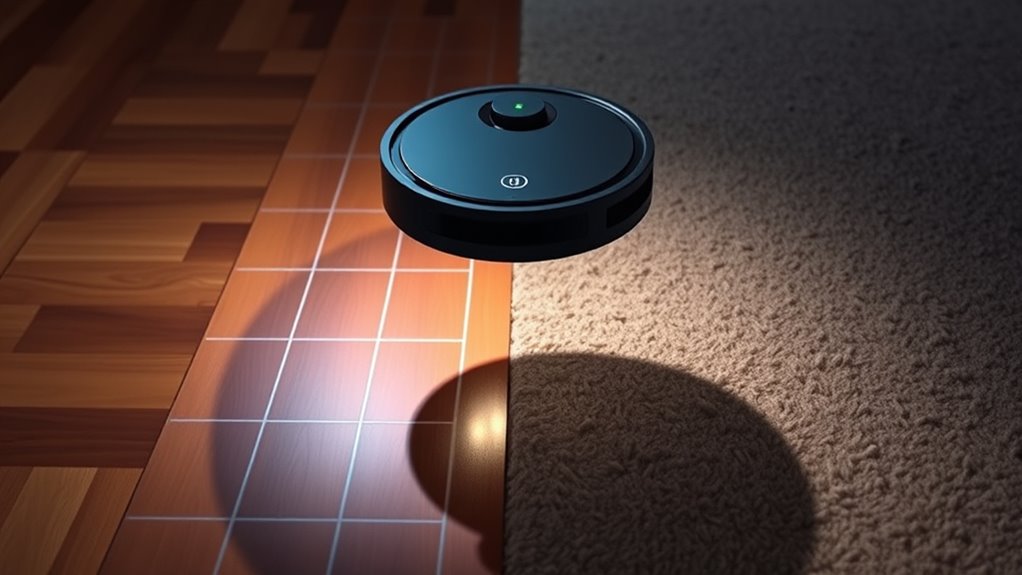
Understanding which cleaning method lasts longer on a single charge depends on several factors. Mapping vacuums generally optimize battery longevity by planning efficient routes, reducing unnecessary movement, and minimizing power consumption. In contrast, random navigation tends to use more power due to repeated coverage and less efficient paths.
Consider these points:
- Mapping vacuums often conserve energy, extending battery life.
- Random models may drain batteries faster due to inefficient coverage.
- Power consumption varies with navigation style, impacting overall runtime.
If you prioritize longer cleaning sessions per charge, mapping vacuums are usually the better choice. They maximize efficiency, reduce unnecessary power use, and help you get more done before recharging. Ultimately, your choice depends on how important battery longevity and power efficiency are to your cleaning routine.
How Mapping Enhances Cleaning Precision and Coverage
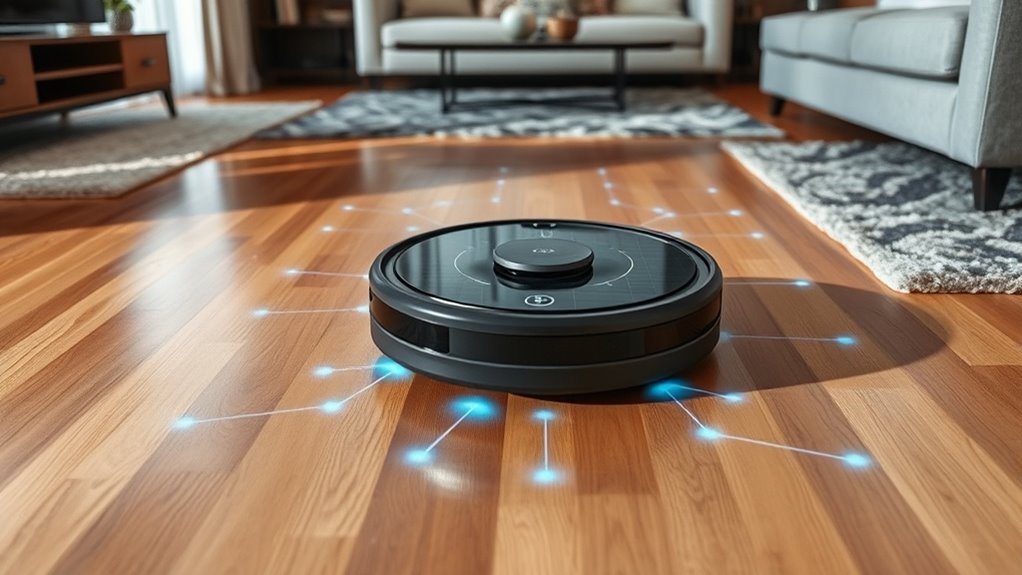
Mapping technology considerably improves cleaning precision and coverage because it enables your vacuum to create a detailed layout of your space. This enhances mapping accuracy, ensuring the device knows exactly where it’s been and where to go next. With precise mapping, your vacuum can systematically cover every inch of your floors without missing spots or doubling back unnecessarily. Obstacle detection plays a crucial role here, allowing the vacuum to identify and navigate around furniture, cords, and other objects seamlessly. This not only boosts cleaning efficiency but also protects your belongings from potential damage. As a result, your vacuum cleans more thoroughly, reducing the time and effort needed for manual intervention. Furthermore, integrating advanced Volkswagen Tuning techniques into the vacuum’s navigation system can optimize route planning for complex layouts. Overall, mapping notably elevates the effectiveness of your cleaning routine.
Cost Considerations: Are Mapping Vacuums Worth the Investment?
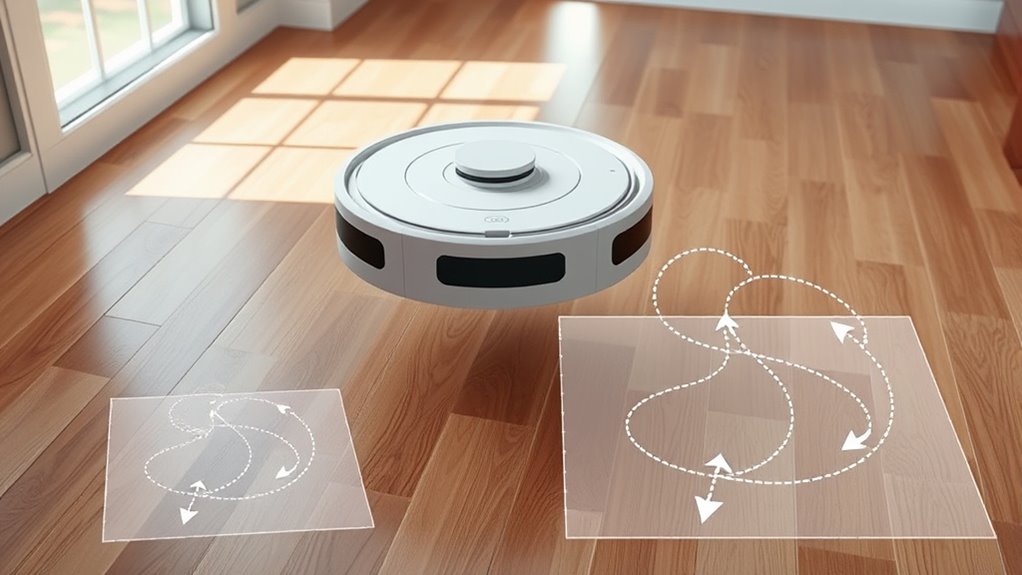
While mapping technology boosts cleaning efficiency, it often comes with a higher price tag. When considering whether these vacuums are worth the investment, you’ll want to do a thorough cost comparison. Think about your budget considerations and whether the advanced features justify the extra expense.
Mapping vacuums improve cleaning but come with higher costs—consider if features justify the investment for your budget.
- Higher upfront costs compared to random navigation models
- Potential savings on cleaning time and repeat passes
- Long-term value from better coverage and fewer missed spots
- Proper maintenance and filter replacement are essential to ensure continued performance and air quality, highlighting the importance of understanding air purifier benefits.
Keep in mind, mapping vacuums tend to be more expensive initially, but their efficiency can offset costs over time. Decide if the improved performance aligns with your budget and cleaning needs. Ultimately, weighing these factors helps determine if the investment makes sense for your home.
Choosing the Right Navigation System for Your Home Needs
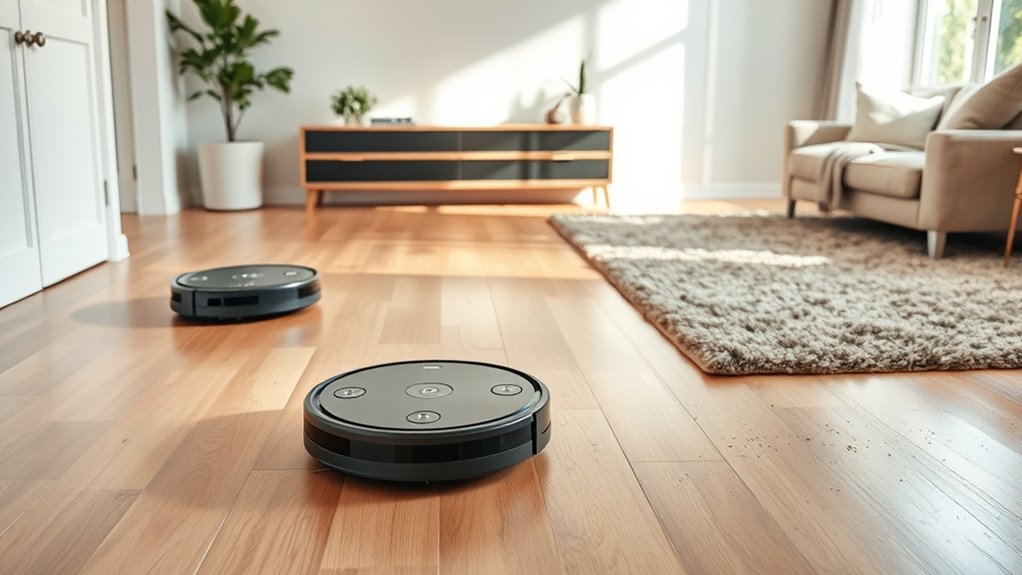
Choosing the right navigation system depends on your home’s layout and your cleaning priorities. If you have pet allergies, you’ll want a vacuum that efficiently captures pet hair and allergens, making mapping systems ideal for thorough coverage. For homes with complex layouts or multiple rooms, mapping vacuums ensure consistent, complete cleaning while avoiding missed spots. Noise levels also matter—if you prefer a quieter operation, look for models designed for low noise. Random navigation vacuums tend to be less expensive and simpler but may not clean as thoroughly or efficiently, especially if noise is a concern. Ultimately, consider your home’s size, the presence of pets, allergy sensitivities, and your noise tolerance to choose a navigation system that best fits your needs.
Frequently Asked Questions
Do Mapping Vacuums Perform Better on Complex Home Layouts?
Yes, mapping vacuums tend to perform better on complex home layouts because they maintain navigation consistency, ensuring thorough cleaning. They create a detailed map of your space, which helps avoid missed spots and inefficient routes. This precision also enhances battery efficiency by reducing unnecessary movements. As a result, your vacuum cleans more effectively and saves battery life, making it ideal for homes with intricate layouts or multiple rooms.
Can Mapping Technology Adapt to New Furniture Arrangements?
Mapping technology can adapt to new furniture arrangements with ease, especially when your vacuum supports regular software updates. Did you know 85% of modern mapping vacuums receive updates that improve their navigation? You’ll find that these updates enhance furniture flexibility, allowing your robot to recognize and navigate around changes. So, if you rearrange your furniture often, choose a model with ongoing software updates to keep performance peak.
Are There Privacy Concerns With Mapping-Enabled Vacuums?
Yes, there are privacy concerns with mapping-enabled vacuums. You should know that these devices collect data about your home’s layout, which raises issues about data collection and security. While many brands claim to protect your privacy, it’s important to review their privacy policies and settings. Be cautious about sharing sensitive information, and consider disabling mapping features if you’re uncomfortable with data collection.
How Does Obstacle Detection Differ Between Mapping and Random Vacuums?
You might think obstacle detection is just about bump sensors, but with mapping vacuums, advanced sensor accuracy and obstacle algorithms make a real difference. They precisely identify and avoid obstacles, updating maps in real-time. Random vacuums rely on basic sensors and simple obstacle algorithms, which can miss or bump into objects. So, mapping vacuums offer smarter navigation, reducing collisions and cleaning more efficiently, while random ones are less precise.
Do Mapping Vacuums Require Professional Installation or Setup?
Mapping vacuums usually don’t require professional installation or setup, but you do need to connect them to your home automation system. You’ll need to run a few initial cleaning cycles to map your space properly. Regular vacuum maintenance, like cleaning sensors and brushes, helps keep the mapping accurate. You can typically set up these vacuums yourself with clear instructions, making them a convenient addition to your smart home.
Conclusion
In the end, whether you choose mapping or random navigation, it’s funny how technology often mirrors life—sometimes we plan meticulously, other times we just go with the flow. Both methods have their perks, but understanding their quirks helps you make smarter choices. You might find that a mapping vacuum’s precision surprisingly complements your unpredictable schedule, reminding you that even in cleaning, a little planning can unexpectedly lead to smoother days. After all, coincidence often guides the best decisions.
